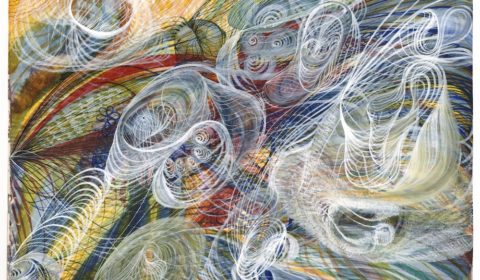
By Sofîa Granados-Dyer
Reprinted with Permission from Backbone Flute.
In 1870, the British spirit medium Georgiana Houghton (1814 – 1884) sent the artist, who she referred to as Mr. L, a series of her drawings. According to Houghton, the drawings were not her own creation per se, but guided by the spirits. After close inspection of the drawings, Mr. L responded:
 My dear Miss Houghton,— I cannot tell you how much I value the wonderful and beautiful drawings you sent me yesterday: the subtlety and delicacy of both the color and the design are to me quite a study: one is constantly seeing something new in its mysterious depths. The little book that you so kindly sent with it will require much thought before it can be understood aright. I am afraid I shall not be able in return to send you anything so original as to line and colour.
My dear Miss Houghton,— I cannot tell you how much I value the wonderful and beautiful drawings you sent me yesterday: the subtlety and delicacy of both the color and the design are to me quite a study: one is constantly seeing something new in its mysterious depths. The little book that you so kindly sent with it will require much thought before it can be understood aright. I am afraid I shall not be able in return to send you anything so original as to line and colour.
Miss Houghton’s drawings were, as Mr. L expressed, nothing short of unique. They consisted of large swaths of red, ochres, blues layered with tightly-coiled white lines. Some of the drawings included faces — of the dead, of herself, of other sitters in the room. Many, however were entirely abstract, seemingly tracing the spirit world’s invisible rhythms.

What is so unique about Houghton’s spirit drawings is that she created them more than half a century before the pioneering Russian artists Vasily Kandinsky and Kazimir Malevich created some of the modern world’s first abstract paintings.* In 1913-1914 Kandinsky painted a series of Compositions of abstract lines and colors. In his paintings he suppressed recognizable objects, and helped popularize total abstraction. Malevich took Kandinsky’s total abstraction to new extremes with the painting Black Square, which is exactly as it sounds: a square canvas painted totally black. While Kandinsky’s abstract shapes at least offer some guesses at familiar forms such as church steeples and fishing boats, Malevich’s black square completely denies any representation. Houghton’s abstract spirit drawings are thus shocking because they produce this very innovation in abstraction 50 years prior.
 Houghton created her spirit drawings in a variety of methods, and always during a séance. She produced her first drawing in 1861. In some, she believed it was a spirit who guided her hand. In others, she attached multiple colored pencils to the end of a planchette in the belief that the spirits would guide it across the paper. These spirit guides ranged from her sister Zilla to the Renaissance artist Titian. Through all of her spirit drawings Houghton maintained the same style of mesmerizing white swirls against watercolor backgrounds.
Houghton created her spirit drawings in a variety of methods, and always during a séance. She produced her first drawing in 1861. In some, she believed it was a spirit who guided her hand. In others, she attached multiple colored pencils to the end of a planchette in the belief that the spirits would guide it across the paper. These spirit guides ranged from her sister Zilla to the Renaissance artist Titian. Through all of her spirit drawings Houghton maintained the same style of mesmerizing white swirls against watercolor backgrounds.
Houghton was considered amateurish in her own time, though did exhibit 155 drawings at a London gallery in 1871. Most recently, the prestigious Courthauld Gallery in 2016 exhibited her drawings. Perhaps these drawings are a chance to speak not to the spirits of Zilla and Titian, but to Houghton, herself.
*Houghton also predated by several decades Swedish artist and spiritualist Hilma af Klint, also identified as a pioneering abstract painter. You can read about Klint here.
Sofía Granados has worked both as a street psychic and séance facilitator. To read more essays by Ms. Granados, check out her Backbone Flute blog, found here.

2 comments on “GUEST ESSAY: Georgiana Houghton’s Victorian Spirit Drawings” Add yours →